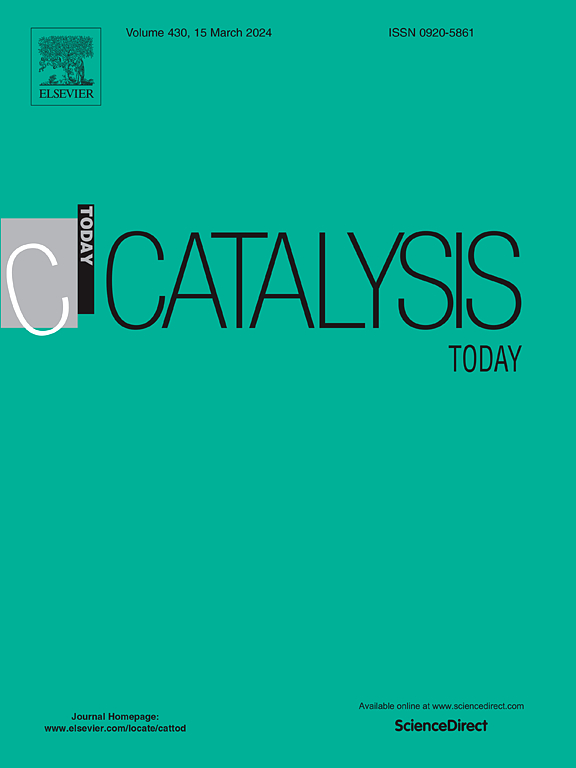IF 5.2
2区 化学
Q1 CHEMISTRY, APPLIED
引用次数: 0
摘要
本研究首次从铝(Al)盐渣废料中通过酸萃取合成了镍改性铝酸镧(Ni/LaAlO3)包晶。萃取铝的方法有两种:2 兆盐酸水溶液(AH)和各种柠檬酸水溶液(0.5、1.0 或 2.0 兆)。为获得纯铝酸镧 (LaAlO3) 相,对三种制备方法(Pechini、改性柠檬酸盐和金属有机凝胶)进行了评估。这项研究还调查了几个因素的影响,并根据所使用的方法观察到一些变化。分析的因素包括(i) 制备方法;(ii) 铝前体溶液的类型(使用 HCl 或 CA 提取);(iii) 配体/阳离子摩尔比(La3 + + Al3+),范围在 0.3 至 3.0 之间;(iv) CA 浓度;(v) 摩尔比(La/Al),范围在 0.5 至 1.0 之间;(vi) 煅烧温度;以及 (vii) 使用稀硝酸(HNO3)水溶液对最终材料进行酸蚀刻。结果表明,使用这三种方法和从盐渣中提取的铝,可以获得 LaAlO3 包晶。在 Pechini 法和金属有机凝胶法中,配体/阳离子摩尔比(La3+ + Al3+)分别为 3.0、0.3(使用 CA)和 1.5(使用 AH)之间,而改良柠檬酸盐法使用的 CA 浓度为 1.0 M。在这三种方法中,获得透辉石的最佳摩尔比(La/Al)均为 1.0。包晶石的合成温度较低,从 650 ℃ 开始,在 950 ℃ 至 1050 ℃ 之间获得完全纯净的形式。稀酸水溶液的处理效果显著,尤其是对使用 2.0 M HCl 萃取的初始溶液得到的材料。这种处理方法对使用 Pechini 方法制备的材料尤为有利,在不影响结晶结构的情况下,使比表面积和总孔隙率增加了 2.5 倍,并使加入的镍(Ni)活性位点具有特异性,特别是β1 可还原物种的比例更高。这一结果提高了甲烷干转化(DRM)反应的催化性能,在反应 20 小时后,二氧化碳转化率高达 73%,甲烷转化率高达 70%,平均选择性为 0.93。这些结果甚至超过了完全使用商业级试剂制备的参考催化剂。炉渣中其他金属的存在以及阳离子取代的多功能性等因素都有助于提高催化剂的理化特性。最终,所有这些都抑制了双壁丝状碳沉积物的形成,这种沉积物往往会因活性相的烧结和变形而使催化剂失活。本文章由计算机程序翻译,如有差异,请以英文原文为准。
Surface tuning of a highly crystalline Ni/LaAlO3 perovskite catalyst obtained from aluminum saline slags using various synthesis methods for the dry reforming of methane
This research presents the first synthesis of nickel-modified lanthanum aluminate (Ni/LaAlO3) perovskite from aluminum (Al) saline slag waste involving acid extraction. Two methods were employed to extract Al: a 2 M HCl aqueous solution (AH) and various citric acid (CA) aqueous solutions (0.5, 1.0, or 2.0 M). Three preparation methods (Pechini, modified citrate, and metal–organic gel) were evaluated to obtain the pure lanthanum aluminate (LaAlO3) phase. This study also investigated the effects of several factors, with some variations being observed depending on the methodology used. The factors analyzed were: (i) preparation method; (ii) type of Al precursor solution (either extracted using HCl or CA); (iii) ligand/cations molar ratio (La3 + + Al3+), ranging from 0.3 to 3.0; (iv) CA concentration; (v) molar ratio (La/Al), between 0.5 and 1.0; (vi) calcination temperature; and (vii) acid etching of the final materials with aqueous dilute nitric acid (HNO3). The results indicated that it is possible to obtain LaAlO3 perovskite using all three methodologies and the Al extracted from saline slags. For the Pechini and metal–organic gel methods, ligand/cations molar ratios (La3+ + Al3+) of 3.0 and between 0.3 (with CA) and 1.5 (with AH), respectively, were obtained, while a CA concentration of 1.0 M was used for the modified citrate method. The optimal molar ratio (La/Al) for obtaining the perovskite was 1.0 in all three methods. The perovskite was synthesized at low temperatures, starting from 650 °C, and was obtained in a completely pure form at between 950 and 1050 °C. Treatment with aqueous dilute acid had a marked effect, especially on the materials obtained when using the initial solution extracted with 2.0 M HCl. This treatment was particularly beneficial for the material prepared using the Pechini method, which induced a 2.5-fold increase in the specific surface area and total pore volume without affecting the crystalline structure, and allowed the specificity of the nickel (Ni) active sites incorporated to be directed, particularly towards a higher proportion of β1 reducible species. This result improved the catalytic performance in the dry reforming of methane (DRM) reaction, achieving conversions of up to 73 % in CO2 and up to 70 % in CH4, with average selectivity of 0.93 after 20 h of reaction. These outcomes even surpassed the reference catalyst, which was entirely prepared using commercial-grade reagents. Factors such as the presence of other metals in the slag and the versatility of cationic substitution contributed to enhancing the physicochemical properties of the catalysts. Ultimately, all of this led to suppression of the formation of double-walled filamentous carbon deposits, which tend to deactivate the catalyst due to sintering and deformation of the active phase.
求助全文
通过发布文献求助,成功后即可免费获取论文全文。
去求助
来源期刊

Catalysis Today
化学-工程:化工
CiteScore
11.50
自引率
3.80%
发文量
573
审稿时长
2.9 months
期刊介绍:
Catalysis Today focuses on the rapid publication of original invited papers devoted to currently important topics in catalysis and related subjects. The journal only publishes special issues (Proposing a Catalysis Today Special Issue), each of which is supervised by Guest Editors who recruit individual papers and oversee the peer review process. Catalysis Today offers researchers in the field of catalysis in-depth overviews of topical issues.
Both fundamental and applied aspects of catalysis are covered. Subjects such as catalysis of immobilized organometallic and biocatalytic systems are welcome. Subjects related to catalysis such as experimental techniques, adsorption, process technology, synthesis, in situ characterization, computational, theoretical modeling, imaging and others are included if there is a clear relationship to catalysis.
 求助内容:
求助内容: 应助结果提醒方式:
应助结果提醒方式:


